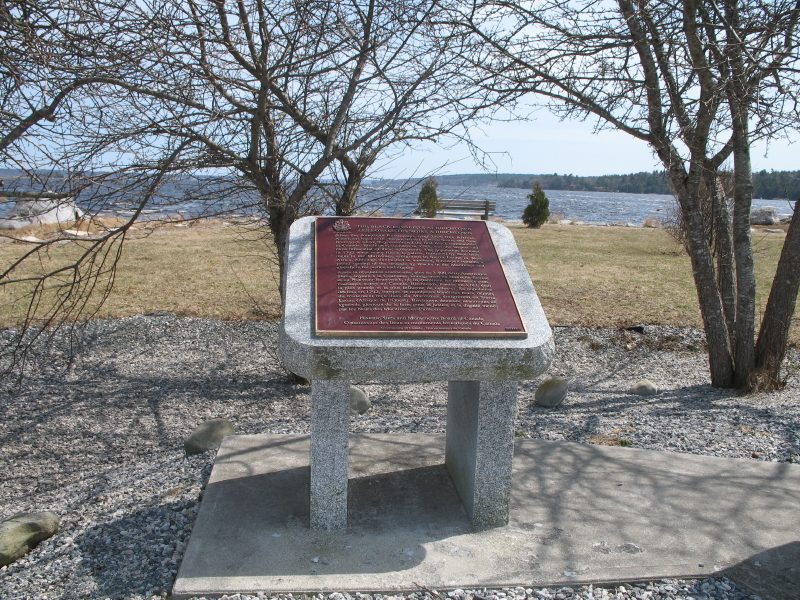
Black Loyalist Plaque in Birchtown, Nova Scotia.
Who were the Loyalists? In broad definitions, they were people from the United States of America, who were supporters of the royalty of Britain and British rule. In more specific terms, there were the Black Loyalists and the White Loyalists, both coming from different areas, different circumstances, and different experiences. They were all united, however, in that the rest of their lives would be filled with constant fear. For the whites, it was the fear of being sacrificed, yet again, by the British.[1] For the blacks, it would be losing their freedom, for they were worried that they would be forced back into slavery, kidnapped, or that their former masters would come back to retrieve them.[2]
When the United States led some uprisings, the British felt the need to increase their military potential. The British soon looked to the half of a million slaves that were present in America. [4] Britain sought to gather supporters from the slaves, and even committed themselves to freeing any slave that was owned by a rebel, and to slaves they would offer them their freedom [5]
Many of the Blacks came from Virginia and South Carolina, and not all were slaves. Some were blacksmiths, cooks, waiters, etc. Most of them came from the poor end of the spectrum, as there were few wealthy Blacks. The use of slaves took place on the other side as well, with George Washington allowing owners to make their slaves into soldiers.
The Blacks left the United States, in order to preserve the freedom and security, that they were promised upon joining the Loyalists. Also, they sought the possibility of equal citizenship, the ability to own land, and possibly equal rights. [9]
Some Loyalists left and went back to England, others, most numbers say about 35 000, [12] sought refuge in Canada, particularly Nova Scotia and New Brunswick.
The impact of the Black Loyalists in Canada should not be minimized, or forgotten. Though the Whites outnumbered the Blacks, the Blacks made several contributions, particularly in labour, the construction of towns, and within their own communities.
Upon arrival in their respective lands, very few Black Loyalists received any land grants, because there were far too many people wanting land, and not enough land to give out. As well, the Blacks were given low priority[13]. So in order to find work, many would settle in Nova Scotian towns, particularly in Shelburne, where there was about 1 500 out of appr
oximately 3 000 free Blacks that came (and about 1 300 black slaves, that came with their Loyalist masters).[14] It is claimed, that the Blacks cleared and built most of the town, as they built barracks, jails and jetties. In addition, they settled in their own communities, such as Birchtown and Brindley Town (of which all residents were black, until 1802, when a white schoolmaster and his family moved there). [15]The Blacks, also, solved the labour shortage. The labour shortage occurred after the arrival of the Loyalists because while most were “pioneering their own farms, larger landowners and urban employers were pressed for workers to make their assets productive”. [16] Seeing as blacks were unable to obtain land, they had to sell their labour. They would do this by doing construction, sharecropping, sailors, farming, or servitude. However, blacks were not given the same high wages were whites, and whites would come to depend on the labour of the blacks, much to the dislike of the whites. There were riots in Shelburne against the Blacks, trying to drive them out of town, and tearing down their homes. The Blacks living outside of communities of fellow Blacks, were often forced back into indentured servitude, which again provided labour for the wealthier white people. This was not limited to blacks, however, and it has to be said, that there were plenty of white indentured servants as well. After years of feeling unequal and not getting what they were promised, many Blacks left to go back to the United States, but more left to go to Sierra Leone.
The Blacks did create impact on the province as a whole, but they created a greater impact within their own isolated communities. The most impact occurred was when a great number of them left, and migration caused economic and social problems. Once, they left, the labour excess, again become a shortage, and wages rose, much to the chagrin of landowners and the suppliers. However, in the research done, there is very little mention of the black Loyalists in many sources, with few exceptions. It is relatively hard to determine, whether this due to the fact that they had little impact, whether there is little evidence to prove otherwise, or whether their contributions were simply swept under a rug or ignored. However, the existence of few articles and books suggests, that their contributions were likely minimized by the contemporaries.
[1] Neil McKinnon, "The Nova Scotia Loyalists: A Traumatic Community," Loyalists and Community in North America, ed. Robert M. Calhoon, Timothy M. Barnes and George A. Rawlyk(London: Greenwood Press, 1994) 202.
[1] James W. St. G. Walker, The Black Loyalists: The Search for a Promised Land in Nova Scotia
and Sierra Leone 1783-1870 (New York: Dalhousie University Press, 1976) 40.
[1] Wallace Brown and Hereward Senior, Victorious in Defeat: The Loyalists inCanada (New York
: Methuen, 1984) 4.
[1] Walker, 1
[1] Walker, 4
[1] Walker , 5
[1] A. G Bradley, The United Empire Loyalists: Founders of British Canada (London: Thornton Butterworth, 1971) 16.
[1] Bradley, 2
[1] Bradley, 18
No comments:
Post a Comment